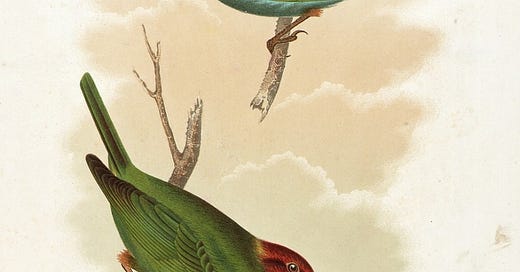Urban greenery holds promise for migratory birds.
City trees and shrubs can harbor both resident and migratory birds.
As I type these words, right outside my window, yellow-rumped warblers alight on tree branches and softly issue their distinctive “tink-tink, tink-tink” calls. There is a small, bushy tree down by our patio where they like to cluster, and they often flit about the branches of the trees that shade our balcony.
Yellow-rumped warblers are migratory birds, overwintering here in Southern California, Mexico, and Central America until spring, when they return to Oregon, Washington, and Canada to breed and raise their young. The warblers readily make their homes among the neighborhoods of San Diego and other nearby cities. During these cooler months, they are one of the more commonly seen bird species in our urban environments. A couple other migratory birds that live in the neighborhoods and canyons of San Diego are vireos and cedar waxwings.
Scientists are finding that our cities and suburbs can be suitable habitats for migrating birds, as well as for a large number of birds that take up residency full time in our urban environments. A study performed in 2014 observed that 20 percent of all bird species live in cities and urban areas.
A previous study from 2013 found that city birds shared traits that make life easier in the big city. These bird species tend to be smaller, eat a wide variety of foods, and have smaller foraging areas. It may be that larger birds need to find more food than what’s available in a city, and having a smaller foraging area may help the city birds avoid hazards such as traffic. Other research finds that bird species are adapting to cities, altering their calls to be more audible among the noises of traffic, and altering the colors of their plumage.
Migratory birds
Cities have often been thought of as the worst thing in the world for migrating bird species. Buildings and streets destroy the birds’ habitat. Birds often die from colliding with skyscrapers. And the bright lights of cities can confuse birds on their migratory paths.
But a study just published in January that looked at migratory birds in Mexico determined that urban environments can also offer these birds refuge.
The authors acknowledge that most migratory bird species have been declining in recent years, and that the most likely cause is the transformation of wildlands into farms, cities, and suburbs in their overwintering regions. It’s estimated that this land transformation causes, on average, a 20 percent population loss for most migrating species.
Nonetheless many migrating birds can find habitat in cities. The researchers looked at urban areas in the central Mexican Plateau region called El Bajío, which contains northwest Mexico City, Guadalajara, and other urban areas. People have lived in this region for thousands of years, and in recent decades this part of Mexico has experienced some of the greatest urban sprawl in the world. It is also a part of the world where a great number of migrating bird species overwinter, birds such as barn swallows and belted kingfishers.
Keep reading with a 7-day free trial
Subscribe to The Green Dispatch to keep reading this post and get 7 days of free access to the full post archives.




